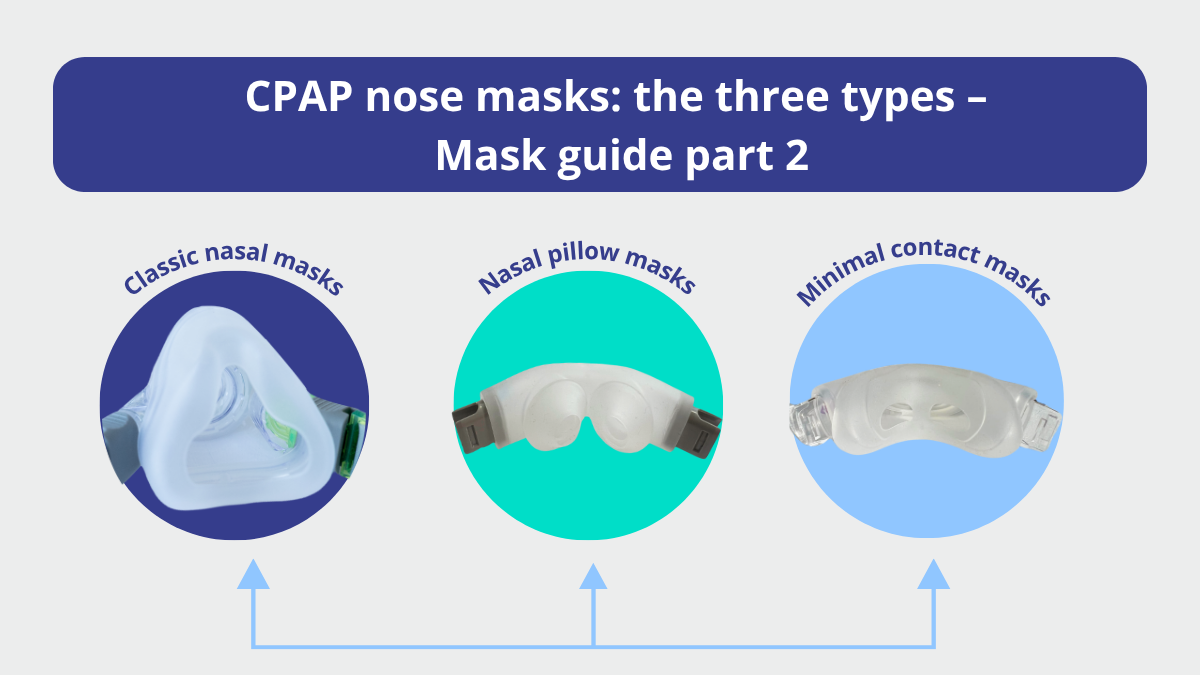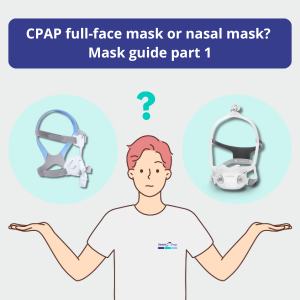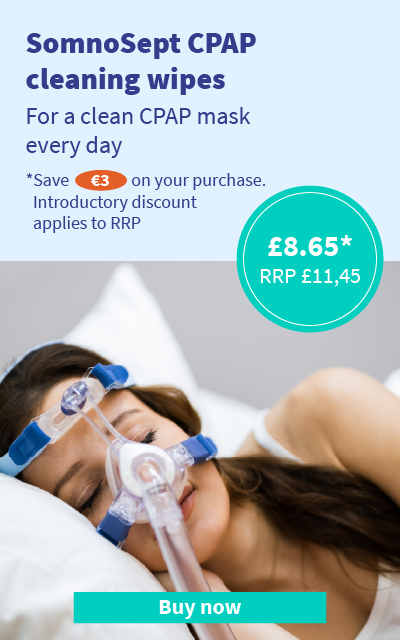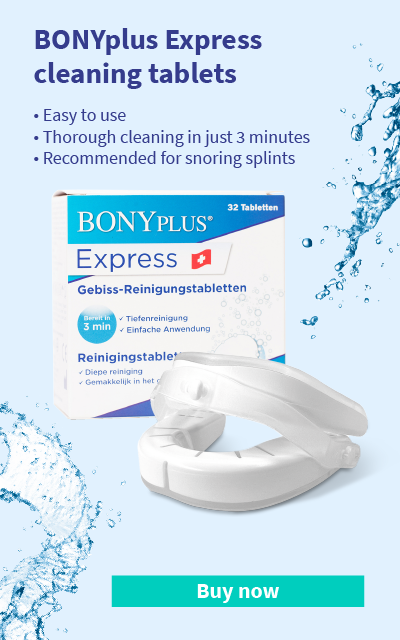Know that you need a CPAP nose mask but unsure how to choose the right one? In this 2nd part of our “Choosing the right CPAP mask” practical guide, we explain how to choose between the three different types of nose masks, namely classic nasal masks, nasal pillow masks and minimal contact masks.
Based on our many years of practical experience, we recommend firstly deciding on a particular type of nasal mask and then having a look at the different manufacturer models within this category.
The differences between the three nose mask types
Here are the differences between the three CPAP nose mask types:
- Classic nasal masks: These masks are characterised by a triangular mask cushion that covers the area from the tip of the nose to the top lip, so it lies on top of the nose too. Older designs such as the ResMed Mirage FX also have forehead support, while newer designs such as the ResMed AirFit N20 do not.
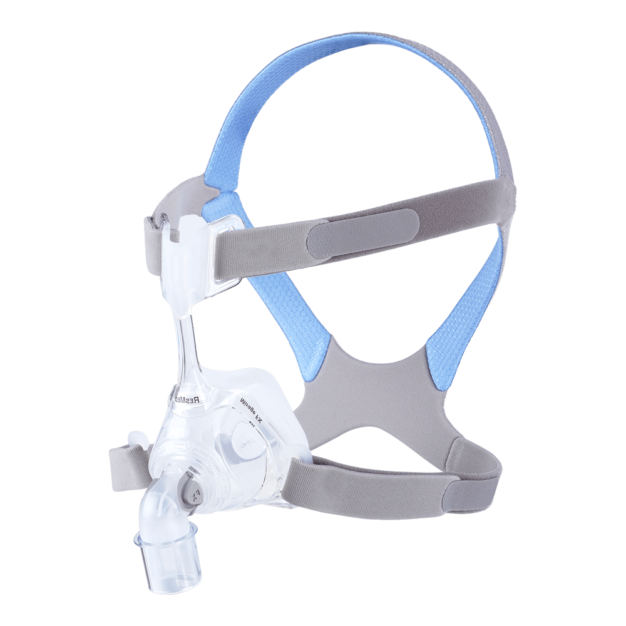
- Nasal pillow masks: These masks use small soft pads that look like nose plugs. These are inserted directly into the nostrils to seal off the nose. A typical example of this mask type is the ResMed AirFit P10.
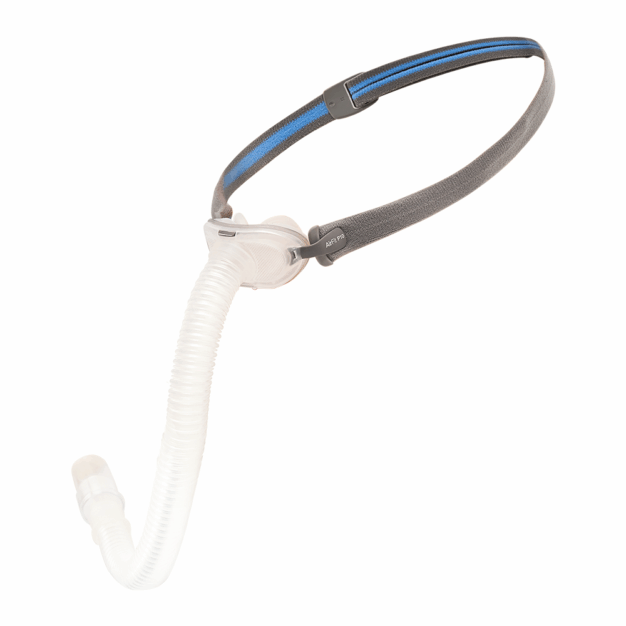
- Minimal contact masks: With these masks, a small pillow sits beneath the nose and covers the nostrils from below. There are no nose plugs. The air flow is fed in either from below just like with classic CPAP masks (as in the AirFit N30, for example) or from above via the side frame (as in the DreamWear Nasal, for example).

Nasal pillow masks and minimal contact masks are generally lighter and less obtrusive than classic nasal masks. They always provide a clear field of vision and help to prevent pressure points on the bridge of the nose.
Which mask type is right for you? The five decision-making criteria to help narrow it down
We’re seeing a clear trend towards minimal contact masks on the CPAP nasal mask market, but working out which mask is right for each particular user is a very individual decision. The following five decision-making criteria can be used as a guide:
- Sleeping position: side-sleeper or back-sleeper? For side-sleepers, nasal pillow masks or minimal contact masks are the most suitable choice. There are two reasons for this. Firstly, they have a flatter profile, so don’t press into the pillows as much, and secondly, the modern versions of these masks also have the hose connection above the head. This keeps the hose out of the way and reduces the risk of becoming tangled in the hose. The pioneering mask in this respect was the Dreamwear nasal mask from, which was then followed by masks such as the AirFit N30i from ResMed. If opting for a classic nasal mask, it is recommended to also purchase a CPAP pillow. These special pillows have cut-outs in the sides that make sure that the CPAP mask doesn’t press into the pillow when the user is sleeping on their side.
- Skin sensitivity: frequent irritation or pressure points? Nasal pillow masks/minimal contact masks are generally beneficial for people with sensitive skin or a tendency to experience pressure points on the bridge of the nose. They have a lot less contact with the face compared to classic nasal masks. If pressure on the bridge of the nose is the main problem, these masks are the preferred choice. In the case of silicone allergies (these are rare), a fabric mask liner can help.
- People with beards/moustaches: Nasal pillow masks or minimal contact masks are the clear recommended choice for people with beards or moustaches. This is because nasal pillow masks such as the AirFit P10 create a seal directly at the nostrils, thereby bypassing the facial hair. This also applies to minimal contact masks such as the Dreamwear nasal mask, though this may still be challenging for users with a very thick moustache. With classic nasal masks, on the other hand, the problem is that a thick moustache may prevent the mask from sitting flush against the skin to create a tight seal.
- Clear field of vision: This is important if you want to read or watch TV before going to sleep but still want to wear the mask while doing so. Nasal pillow masks and minimal contact masks often have the advantage of offering a clear field of vision, as there’s no forehead support in the centre. However, modern nasal masks such as the AirFit N20 do not have this forehead support. In the case of nasal pillow masks or minimal contact masks with the hose connection above the head (such as the Dreamwear nasal mask, for example), these feel even less obtrusive.
- Volume of the CPAP mask: It goes without saying that it’s important to have peace and quiet in the bedroom and that nobody wants their CPAP therapy to disturb their sleeping partner. CPAP masks are generally very quiet, but nasal pillow masks such as the AirFit P10 are super-quiet, with a sound level of just 21 dB(A). Just as a comparison, the ticking of a quartz watch has a sound level of 15 to 25 dB(A). Classic nasal masks are particularly quiet if they have a damping element at the air outlet like the Eson 2, as the disruptive noise comes particularly from the values for the exhaled air.
Conclusion: Which mask type is right for you?
In summary, we can say that nasal pillow masks/minimal contact masks are preferred by:
- Side-sleepers (masks barely press into the face/do not press into the face intensely when the user lies on their side)
- People with beards (nasal pillow masks bypass the facial hair)
- People who value a clear field of vision, e.g. for reading (these masks offer this as standard)
- People with sensitive skin on the bridge of the nose (the masks sit under the nose)
Classic nasal masks could be a good choice for:
- Users who require a very stable mask: Some users find the larger contact surface more stable.
- People who find direct pressure on or in the nostrils unpleasant.
- Users who require higher therapy pressures: Although a lot of minimal contact masks are suitable for higher pressures, classic nasal masks are traditionally robust in this area.
Buy CPAP nasal masks at favourable prices
All major CPAP mask manufacturers – find the perfect CPAP nasal mask for your sleep apnoea therapy here.
Full-Face or Nasal CPAP Mask? CPAP Mask Guide – Part 1
Find out why nasal masks are often the better choice for your therapy. Learn how to choose the right CPAP mask in just a few steps.
Dr. Daniel Grätz is the Managing Director of health.On Ventures GmbH, one of Germany’s leading online providers of snoring mouth guards, and has been providing customers with advice about these devices for many years.


